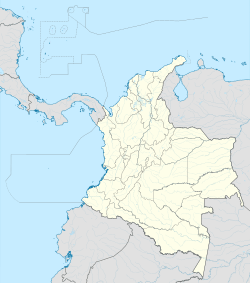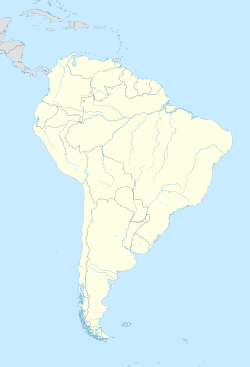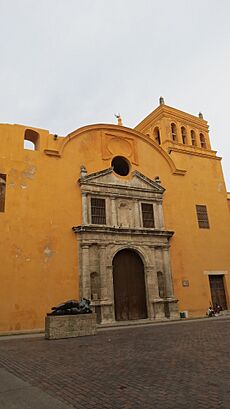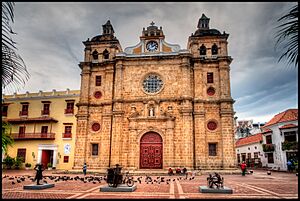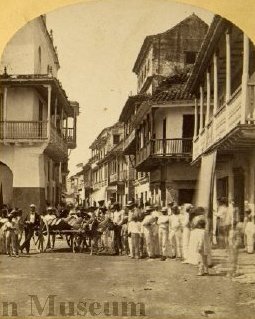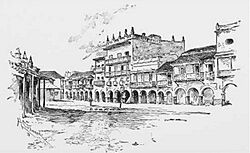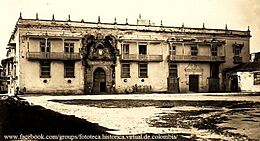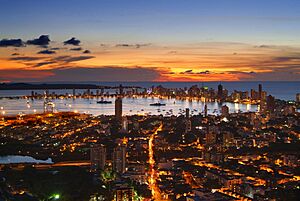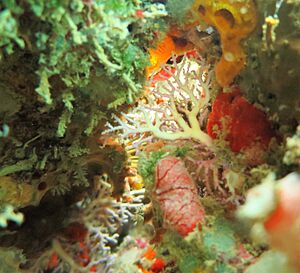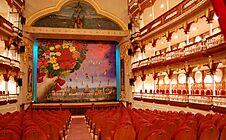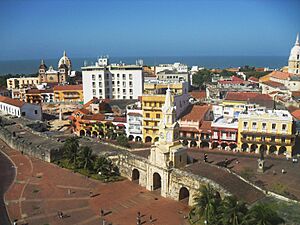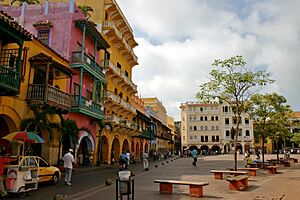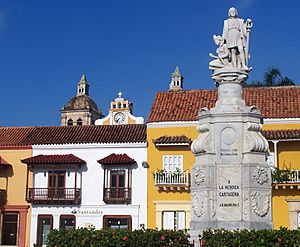Cartagena, Colombia facts for kids
Quick facts for kids
Cartagena
|
|||
|---|---|---|---|
|
District and city
|
|||
| Cartagena de Indias | |||
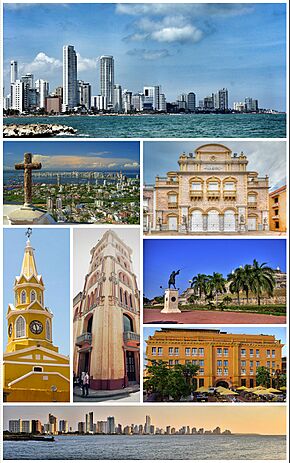
Top: Bocagrande Harbor. Second row: View of Santa Cruz Manga Island, Heredia Theatre. Third row: ClockTower (Torre del Reloj), Pilar Republicano, San Felipe Barajas Castle (Castillo de San Felipe de Barajas) (above), Charleston Hotel (below). Bottom: City Skyline.
|
|||
|
|||
| Nicknames:
La ciudad mágica (The Magic City)
La ciudad cosmopolita (The Cosmopolitan City) La heroica (The Heroic) El corralito de piedra (The Rock Corral) La fantástica (The Fantastic) |
|||
| Motto(s):
"Por Cartagena"
|
|||
 |
|||
| Country | Colombia | ||
| Department | Bolívar | ||
| Region | Caribbean | ||
| Foundation | 1 June 1533 | ||
| Founded by | Pedro de Heredia | ||
| Named for | Cartagena, Spain | ||
| Area | |||
| • District and city | 83.2 km2 (32.1 sq mi) | ||
| • Metro | 597.7 km2 (230.8 sq mi) | ||
| Elevation | 2 m (7 ft) | ||
| Population
(2020)
|
|||
| • District and city | 914,552 | ||
| • Rank | Ranked 5th | ||
| • Density | 10,992/km2 (28,470/sq mi) | ||
| • Metro | 1,028,736 | ||
| • Metro density | 1,721/km2 (4,460/sq mi) | ||
| Demonym(s) | Cartagenero(s) | ||
| GDP (PPP, constant 2015 values) | |||
| • Year | 2023 | ||
| • Total | $17.1 billion | ||
| • Per capita | $15,600 | ||
| Time zone | UTC-5 (COT) | ||
| Postal code |
130000
|
||
| Area code(s) | 57 + 5 | ||
| Patron saints | Saint Catherine and Saint Sebastian | ||
| Average temperature | 30 °C (86 °F) | ||
| City tree | Arecaceae | ||
| Official name: Port, Fortresses and Group of Monuments, Cartagena | |||
| Type: | Cultural | ||
| Criteria: | iv, vi | ||
| Designated: | 1984 (8th session) | ||
| Reference #: | 285 | ||
| Region: | Latin America and Caribbean | ||
Cartagena (pronounced KAR-tuh-HAY-nuh), also known as Cartagena de Indias, is a big city and important port on the northern coast of Colombia. It's located in the Caribbean Coast Region, right by the Caribbean Sea.
Long ago, Cartagena was a key stop on trade routes to the West Indies. This makes it very important for understanding world exploration and preserving history. As a former Spanish colony, it was a main port for sending silver from Bolivia to Spain. It was also a place where enslaved people from Africa were brought in under a special system. The city was built to be strong against pirate attacks. Its location near the Magdalena and Sinú Rivers also made it easy to reach inland areas, making it a major trade center by the 1540s.
Today, Cartagena is the capital of the Bolívar Department. In 2018, it had about 876,885 people. This makes it the second-largest city in Colombia's Caribbean region and the fifth-largest city in the whole country. The larger area around Cartagena is the sixth-largest urban area in Colombia. The city's economy relies on shipping, oil and gas industries, and especially tourism.
The city was named after Cartagena, Spain, and also after the ancient city of Carthage. It was founded on June 1, 1533, making it one of South America's oldest colonial cities. However, people lived around Cartagena Bay much earlier, starting around 4000 BC. During the Spanish colonial period, Cartagena played a big role in the Spanish empire. It was a center for government, church activities, and business. In 1984, the old walled city and its forts were named a UNESCO World Heritage Site.
Cartagena was also the site of a famous battle in 1741, called the Battle of Cartagena de Indias. This battle was part of the War of Jenkins' Ear between Spain and Britain.
Contents
History of Cartagena
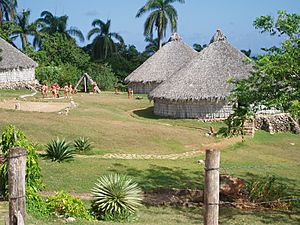
Who lived in Cartagena before the Spanish arrived?
The Puerto Hormiga Culture was one of the first known human groups in what is now Colombia. They lived near the Sinú River Delta and Cartagena Bay around 4000 BC. Archeologists have found the oldest pottery in the Americas from this time and place. The area had a good climate and lots of wildlife, which made life easy for these early people.
Around 3000 BC, the Puerto Hormiga culture declined. A new culture, the Monsú, rose up. They lived near the Dique Canal. The Monsú people also made pottery and had a mixed economy of farming and making goods. They mostly ate shellfish and fish.
Later, the Sinú society developed in other parts of the region. Before the Spanish colonization, many different tribes lived along the Colombian Caribbean coast. These included groups from the Karib, Malibu, and Arawak language families. Around 1500 AD, the area around Cartagena Bay was home to Mocanae tribes, part of the Karib family.
Some of these Mocanae villages were:
- Kalamarí (Calamari) on a sandy island facing the ocean.
- Carex on Tierrabomba Island.
- Bahaire on Isla Barú, which was then a peninsula.
- Cospique in the area of Mamonal.
- Yurbaco Tribe in the suburban area of Turbaco.
The Kalamari tribe was the most important among these groups. These tribes lived in huts with round rooms and tall roofs. They also built wooden fences to protect their villages.
When did Europeans first see Cartagena?

In 1500, Rodrigo de Bastidas explored the coast. Later, in 1527, he saw the Magdalena River Delta. Other explorers like Diego de Nicuesa and Alonso de Ojeda had noticed a large bay on their way to Panama. This encouraged Bastidas to explore it further.
Early attempts by other explorers to set up settlements in the southern Caribbean failed. This made the area less appealing to colonizers for a while. They preferred places like Hispaniola and Cuba.
How did the Spanish build Cartagena?
On January 14, 1533, Spanish commander Pedro de Heredia arrived at Cartagena Bay with three ships and 150 men. He found the Calamari village empty. He then fought a battle in Turbaco and won. With the help of a local guide named India Catalina, Heredia explored the area for three months. He returned with a lot of gold, including a large gold porcupine. Heredia later found more gold from ancient tombs. He was governor of Cartagena for 22 years.
Cartagena was officially founded on June 1, 1533, by Pedro de Heredia. He named it after the port city of Cartagena, Spain, where many of his sailors were from. In 1574, King Philip II gave Cartagena the title of "city."
The city became very important for sending silver from Bolivia to Spain. This made it a target for pirates and privateers from France, England, and Holland. In 1544, the French pirate Jean-François Roberval attacked the city. Heredia had to pay a ransom. A defensive tower was built in 1566, but it wasn't enough. In 1569, another French pirate, Martin Cote, attacked and robbed the city.
After Cote's attack, a fire destroyed much of the city. This led to the creation of the first firefighting team in the Americas.
In 1568, Sir John Hawkins tried to trade with Cartagena, which was against Spanish law. He then attacked the city for 8 days but failed. In 1586, Francis Drake attacked with 23 ships and 3,000 men. Drake burned 200 houses and the cathedral. He left only after a ransom was paid.
After these attacks, Spain hired an engineer named Bautista Antonelli in 1586. He designed a plan to build strong defenses for all Spanish ports in the Caribbean, including Cartagena.
In 1610, the Holy Office of the Inquisition was set up in Cartagena. The Palace of Inquisition was finished in 1770. This court dealt with crimes like heresy and witchcraft. It was abolished in 1811 when Colombia became independent.
Cartagena became a major market for enslaved people in the 17th century. European traders brought enslaved Africans to the city. Spain relied on a system where other European nations were given permission to trade enslaved people to Spanish territories.
Governor Francisco de Murga built many forts to protect the bay, making it very strong. Walls were also built around the historic district and the Getsemani area. These defenses included the Castillo San Felipe de Barajas, which was completed in 1654 and later expanded. It had underground tunnels and galleries to help defend the city.
In 1697, French privateers led by Bernard Desjean, Baron de Pointis attacked Cartagena. They took over the forts and bombarded the city. The governor surrendered, and the French took a lot of treasure.
The construction of Cartagena's fortifications continued for 200 years. These included forts like San Jose and San Luis de Bocachica at Bocachica, and San Juan del Manzanillo and Santa Cruz O Castillo Grande inside the bay. The city itself was surrounded by a ring of walls and bastions.
How did Cartagena change in the 1700s?

The 18th century started slowly for Cartagena's economy. However, with the creation of the Viceroyalty of New Granada and ongoing conflicts between Spain and Britain, Cartagena became known as the "gateway to the Indies of Peru." By 1777, the city had about 13,700 people and a garrison of 1,300 soldiers. The population grew to 17,600 by 1809.
In 1731, a military academy was founded in Cartagena. Juan de Herrera y Sotomayor, who designed the Puerta del Reloj (Clock Gate), was also important during this time.
The Big Attack of 1741
In April 1741, a large British fleet led by Admiral Edward Vernon attacked Cartagena. This was part of the War of Jenkins' Ear. The British had 50 warships, 130 transport ships, and 25,600 men. The Spanish defense was led by Sebastián de Eslava and Don Blas de Lezo. The British managed to take some forts and land troops.
However, a big attack on San Felipe Barajas on April 20, 1741, failed. The British lost 800 men and had 1,000 taken prisoner. Vernon then ended the siege because many of his men were sick with tropical diseases. An interesting fact: George Washington's half-brother, Lawrence Washington, was among the North American troops. He later named his home, Mount Vernon, after Admiral Vernon.
After this, engineer Antonio de Arebalo continued to strengthen Cartagena's defenses. From 1771 to 1778, he built a long underwater wall called the Escollera across Bocagrande.
How did Cartagena become independent?
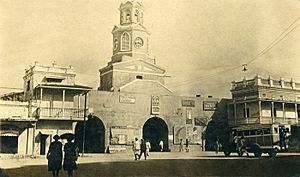
Cartagena was under Spanish rule for over 275 years. When Napoleon captured the Spanish kings, the wars for independence began in Latin America. In Cartagena, on June 4, 1810, the city council removed the Spanish governor. A new local government was formed. On November 11, 1811, Cartagena signed a Declaration of Independence, declaring itself "a free state, sovereign and independent."
Spain sent a large army to take back control. On August 22, 1815, they started a siege of the city. The city was defended by 3,000 men. By December 5, about 300 people were dying each day from hunger or disease. Many tried to escape. After the city fell, the Spanish commander executed nine rebel leaders.
Finally, a patriot army led by General Mariano Montilla and Admiral José Prudencio Padilla besieged the city again from August 1820 to October 1821. After the Spanish governor surrendered, Simon Bolivar, the Liberator, gave Cartagena the title "Heroic City."
After independence, Cartagena faced hard times. It lost the money it received as a military outpost. Its population dropped and didn't recover until the 20th century. Diseases, like a cholera epidemic in 1849, also caused problems. The Canal del Dique, which connected the city to the Magdalena River, became blocked with mud, reducing trade. The rise of the port of Barranquilla also hurt Cartagena's trade.
However, during the presidency of Rafael Núñez, who was from Cartagena, the government invested in a railroad and other improvements. This helped the city recover and grow again.
Geography of Cartagena
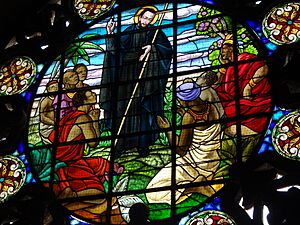
Where is Cartagena located?
Cartagena is in northern Colombia, at 10°25'N 75°32'W. It faces the Caribbean Sea to the west. To the south is Cartagena Bay, which has two entrances: Bocachica (Small Mouth) in the south and Bocagrande (Big Mouth) in the north. The beaches are often made of dark, volcanic sand.
Cartagena Bay is an estuary, which is where a river meets the sea. It covers about 84 square kilometers.
What are Cartagena's neighborhoods like?
Northern area
The Rafael Núñez International Airport is in the Crespo neighborhood, about ten minutes from the old city. North of the airport is Zona Norte, which has hotels, new buildings, and schools. The old city walls are southwest of Crespo. Between Crespo and the old city are the neighborhoods of Marbella and El Cabrero.
Downtown
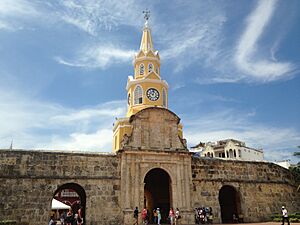
Downtown Cartagena has a mix of old colonial buildings and newer republican and Italian styles. The main entrance to downtown is the Puerta del Reloj (Clock Gate). This gate leads to the Plaza de los Coches (Square of the Carriages). Nearby are the Plaza de la Aduana (Customs Square) and the mayor's office.
You can also find San Pedro Claver Square and the church named after Saint Peter Claver. His body is kept there. The Museum of Modern Art is also close by.
The Plaza de Bolívar (Bolívar's Square) is a small park with a statue of Simón Bolívar. It's surrounded by old buildings with balconies and outdoor cafes. The Office of Historical Archives, which holds Cartagena's history, is nearby. Next to it is the Government Palace. Across from the palace is the Cathedral of Cartagena, which was built in the 1500s.
Another important church is the Iglesia de Santo Domingo, in front of Plaza Santo Domingo. In this square, you can see a sculpture called Mujer Reclinada ("Reclining Woman") by Colombian artist Fernando Botero.
The Augustinian Fathers Convent and the University of Cartagena are also in the city. The university is a public higher education center. The Claustro de Santa Teresa (Saint Theresa Cloister) is now a hotel. It has its own square, protected by the San Francisco Bastion.
About a 20-minute walk from downtown is the Castillo de San Felipe de Barajas. This is one of the biggest forts built by the Spanish in their colonies. It has tunnels designed to help defenders hear enemies approaching. Some tunnels are open for visitors today.
Cartagena's walled Old City is famous for its beautiful plazas and colorful Spanish colonial buildings.
San Diego
San Diego is named after the San Diego Convent, which is now the Beaux Arts University Building. Across from it is the Convent of the Nuns of the Order of Saint Clare, now the Hotel Santa Clara. The Santo Toribio Church, the last church built in the Walled City, is also here.
Inside the Old City, you'll find Las Bóvedas (The Vaults). This building is part of the Santa Catalina Fortress walls. From its top, you can see the Caribbean Sea.
Getsemaní
Getsemaní, just south of the old walled city, has become a very popular neighborhood. Plazas have been improved, and old buildings are now boutique hotels. Getsemaní is known as a "Ciudad Mural" (Mural City) because of its many wall paintings that show the local culture and history.
Bocagrande
Bocagrande (Big Mouth) is known for its tall buildings. This area has most of the city's tourist facilities, like hotels, shops, restaurants, and nightclubs. It's located between Cartagena Bay and the Caribbean Sea. It includes the neighborhoods of El Laguito (The Little Lake) and Castillogrande (Big Castle). Bocagrande has long beaches and many shops along Avenida San Martín.
The beaches in Bocagrande have volcanic sand, which is a bit grayish. This can make the water look cloudy, but it's clean. There are stone walls (breakwaters) every 200 meters or so to protect the shore.
On the bay side of Bocagrande, there's a seawalk. In the middle of the bay, there's a statue of the Virgin Mary. The Naval Base is also in Bocagrande.
What is Cartagena's climate like?
Cartagena has a tropical wet and dry climate. The air is usually very humid, around 90%. The rainy season is typically from May to November. The weather is generally hot and windy.
| Climate data for Cartagena (Rafael Núñez International Airport) 1991–2020 | |||||||||||||
|---|---|---|---|---|---|---|---|---|---|---|---|---|---|
| Month | Jan | Feb | Mar | Apr | May | Jun | Jul | Aug | Sep | Oct | Nov | Dec | Year |
| Record high °C (°F) | 40.0 (104.0) |
38.0 (100.4) |
38.0 (100.4) |
38.0 (100.4) |
40.0 (104.0) |
39.8 (103.6) |
39.0 (102.2) |
38.0 (100.4) |
39.6 (103.3) |
39.0 (102.2) |
40.0 (104.0) |
38.0 (100.4) |
40.0 (104.0) |
| Mean daily maximum °C (°F) | 31.1 (88.0) |
31.1 (88.0) |
31.2 (88.2) |
31.7 (89.1) |
32.0 (89.6) |
32.3 (90.1) |
32.2 (90.0) |
32.2 (90.0) |
32.1 (89.8) |
31.7 (89.1) |
31.5 (88.7) |
31.4 (88.5) |
31.7 (89.1) |
| Daily mean °C (°F) | 26.9 (80.4) |
27.0 (80.6) |
27.3 (81.1) |
28.1 (82.6) |
28.6 (83.5) |
28.9 (84.0) |
28.6 (83.5) |
28.7 (83.7) |
28.6 (83.5) |
28.3 (82.9) |
28.1 (82.6) |
27.5 (81.5) |
28.0 (82.4) |
| Mean daily minimum °C (°F) | 24.0 (75.2) |
24.2 (75.6) |
24.9 (76.8) |
25.8 (78.4) |
26.1 (79.0) |
26.1 (79.0) |
25.7 (78.3) |
25.9 (78.6) |
25.8 (78.4) |
25.6 (78.1) |
25.5 (77.9) |
24.8 (76.6) |
25.4 (77.7) |
| Record low °C (°F) | 19.0 (66.2) |
19.0 (66.2) |
19.0 (66.2) |
19.5 (67.1) |
19.0 (66.2) |
19.0 (66.2) |
20.0 (68.0) |
18.0 (64.4) |
18.5 (65.3) |
19.0 (66.2) |
19.0 (66.2) |
18.5 (65.3) |
18.0 (64.4) |
| Average precipitation mm (inches) | 0.5 (0.02) |
0.3 (0.01) |
0.2 (0.01) |
18.6 (0.73) |
117.4 (4.62) |
92.5 (3.64) |
121.1 (4.77) |
127.5 (5.02) |
133.1 (5.24) |
236.5 (9.31) |
178.3 (7.02) |
44.7 (1.76) |
1,073.8 (42.28) |
| Average precipitation days (≥ 1 mm) | 0.1 | 0.1 | 0.4 | 2.0 | 7.0 | 8.5 | 8.5 | 9.5 | 10.3 | 12.1 | 8.9 | 2.6 | 70.1 |
| Average relative humidity (%) | 81 | 79 | 80 | 81 | 82 | 82 | 81 | 82 | 82 | 83 | 83 | 82 | 81 |
| Mean monthly sunshine hours | 272.8 | 240.1 | 238.7 | 210.0 | 192.2 | 189.0 | 207.7 | 198.4 | 171.0 | 170.5 | 186.0 | 241.8 | 2,518.2 |
| Mean daily sunshine hours | 8.8 | 8.5 | 7.7 | 7.0 | 6.2 | 6.3 | 6.7 | 6.4 | 5.7 | 5.5 | 6.2 | 7.8 | 6.9 |
| Mean daily daylight hours | 11.6 | 11.8 | 12.1 | 12.4 | 12.6 | 12.7 | 12.7 | 12.5 | 12.2 | 11.9 | 11.7 | 11.5 | 12.1 |
| Percent possible sunshine | 75.9 | 66.6 | 63.8 | 56.6 | 49.3 | 49.5 | 52.9 | 51.4 | 46.8 | 46.2 | 53.2 | 67.7 | 56.7 |
| Average ultraviolet index | 11 | 11 | 13 | 15 | 13 | 13 | 12 | 13 | 13 | 13 | 11 | 10 | 12 |
| Source 1: Instituto de Hidrologia Meteorologia y Estudios Ambientales (humidity, sun 1971-2010) | |||||||||||||
| Source 2: Weather Atlas(daylight) Nomadseason(UV index) | |||||||||||||
People of Cartagena

{{wide image|58 - Carthagène - Décembre 2008.jpg|880px|Panorama of Cartagena from the San Felipe de Barajas Fort, in 2008.]]
What is the ethnic makeup of Cartagena?
According to the 2005 census, the people of Cartagena are:
- Whites and Mestizos (mixed European and Indigenous): 63.2%
- Black, mulatto, or Afro-descendant: 36.1%
- Palenquero: 0.3%
- Indigenous: 0.2%
- ROM: 0.1%
- Raizal: 0.1%
Economy of Cartagena
The main ways people make money in Cartagena are through industry, tourism, and trade. The port of Cartagena is one of the biggest in South America.
What industries are in Cartagena?
Cartagena has many important companies. These include those involved in cement, food, drinks, and chemicals.
What is Miss Colombia?
The Miss Colombia beauty pageant started in Cartagena in 1934. The winner, Señorita Colombia, goes to the Miss Supranational contest. The runner-up, Señorita Colombia Internacional, goes to Miss International.
There's also a local contest where neighborhoods choose young women to be named Miss Independence.
What are Free Zones?
Free zones are special areas in the city. They have different customs and tax rules to help businesses. These zones encourage making goods and providing services, mainly for international trade.
- Parque Central Zona Franca: This zone opened in 2012. It's located near Turbaco, close to Cartagena. It covers about 115 hectares.
- Zona Franca Industrial Goods and Services ZOFRANCA Cartagena SA: This zone is 14 km from the city center. It has a private dock.
- Zona Franca Turística en Isla De Barú: This zone is on Isla Barú. It was approved in 1993 and focuses on water activities, marine tourism, and urban development.
Why is tourism important to Cartagena?
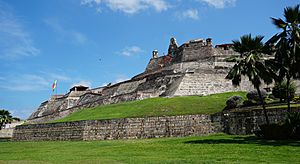
Tourism is a very important part of Cartagena's economy. Here are some popular places to visit in the walled city:
- Colonial architecture: Many houses have balconies with colorful tropical flowers.
- Convent of La Popa: Located at the top of Mount Popa, it offers great views.
- Cathedral of Santa Catalina de Alejandría: A beautiful historic church.
- Church and cloister of San Pedro Claver: A significant religious site.
- Convent and church of Santo Domingo: Another old and important church.
- Palace of Inquisition: A historic building with a museum.
- Teatro Heredia: A grand theater.
- Cartagena Gold Museum: Shows gold and pottery from the ancient Zenú culture.
- Las Bóvedas: Old vaults built into the city walls, now shops.
- Clock Tower (Puerta del Reloj): The main entrance to the old city.
- Fortresses: Cartagena has many strong forts and walls. These were designed by engineers like Battista Antonelli and Antonio de Arévalo. They made Cartagena a very well-protected city. The Castillo de San Felipe de Barajas is a famous example.
The city has many hotels, from small boutique hotels in the Walled City to larger ones in Bocagrande. The Getsemaní area also has many small hotels and hostels.
Outside the city, a popular tourist spot is:
- Las Islas del Rosario: These islands are a national park. Most can be reached by boat in about an hour from the city docks.
Infrastructure
How do people get around Cartagena?
As a major city for business and tourism, Cartagena has many ways to get around. This includes its seaport, airport, and river transport.
In 2003, the city started building Transcaribe, a public transport system. It began operating in 2015. Taxis are also common, and there's a bus terminal connecting Cartagena to other cities.
Cartagena sometimes has problems with traffic jams.
Roads
The city is connected to the northern Caribbean Region by roads 90 and 90A. These roads go through Barranquilla, Santa Marta, and Riohacha. Taxis in the city do not use fare meters.
Road 25 goes through Turbaco and Arjona. It connects to other major cities like Sincelejo and Medellín.
Air travel
The Rafael Núñez International Airport is the busiest airport in Colombia's Caribbean region. It's the fourth busiest in the country for passengers. It has flights to most airports in Colombia, including Bogota's El Dorado International Airport. Some international flights now go to Panama or Aruba because of lower costs and easier connections.
Sea travel
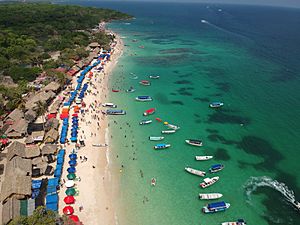
Cartagena is Colombia's most important port in the Caribbean.
The city has several open ports:
- Port Society of Cartagena: This port specializes in handling containers. It's the best in Colombia for this, the third busiest in the Caribbean Sea, and ranked 99th globally.
- Muelles El Bosque (El Bosque Docks): This port stores grain and is expanding into container handling.
- Container Terminal of Cartagena: Focuses on managing containers.
There are also private ports for specific companies like the Cartagena Oil Refinery, SABMiller brewery, and Dow Chemical.
Canals
Since the 17th century, Cartagena Bay has been connected to the Magdalena River by the Dique Canal. This canal was built by Governor Pedro Zapata de Mendoza. After Colombia became independent, the canal was not maintained well. It still works, but needs more care.
Education
Colleges and universities
- University of Cartagena
- Universidad Tecnológica de Bolívar
Primary and secondary schools
Some international schools in Cartagena include:
- Corporacion Educativa Colegio Britanico de Cartagena (British)
- Gimnasio Cartagena de Indias (International)
- Colegio Jorge Washington (American)
Libraries
Cartagena has many public and private libraries:
- The Universidad de Cartagena José Fernández Madrid Library: Opened in 1821 with the university. It mainly serves students and teachers but is open to everyone.
- The Bartolomé Calvo Library: Founded in 1843, it's one of the main libraries on the Caribbean Coast.
- The History Academy of Cartagena de Indias Library: Opened in 1903. It has many old books.
- The Technological University of Bolívar Library: Opened in 1985. It has large sections on engineering and electronics.
- The American Hispanic Culture Library: Opened in 1999. It focuses on Hispanic culture and history.
- Jorge Artel Library: Opened in 1997. It mainly serves children in the southwest districts.
- Balbino Carreazo Library: Located in Pasacaballos, it serves the suburbs.
- District Libraries: These smaller libraries are in different neighborhoods and have about 5,000 books each.
Culture
Theaters and concert halls
The first theaters in New Granada operated on what is now Calle del Coliseo.
- Teatro Adolfo Mejía: Formerly Teatro Heredia, it opened in 1911. It was rebuilt in the 1990s and is still a cultural center.
Sport
- Baseball: The Tigres de Cartagena represent the city in the Colombian Professional Baseball League. They play at Estadio Once de Noviembre.
- Football (Soccer): The main football club is Real Cartagena.
- In August 2024, Cartagena helped host the 2024 U-15 Baseball World Cup.
Museums and galleries

- City Museum Palace of the Inquisition: Opened in the 1970s.
- Sanctuary and Museum of St. Maria Bernarda Bütler: Dedicated to the founder of a religious order.
World Heritage Site
In 1984, UNESCO chose Cartagena's port, fortresses, and monuments as a World Heritage Site. This is because it has the most extensive (largest) fortifications in South America. The city is divided into three main historic neighborhoods:
- San Sebastian and Santa Catalina: Where the cathedral and palaces for wealthy people and government buildings were located.
- San Diego or Santo Toribio: Where merchants and the middle class lived.
- Getsemani: The popular suburban area.
Festivities
- January: "Cartagena International Music Festival" (Classical music). "SummerLand Festival" (Electronic music).
- February: "Fiestas de Nuestra Señora de la Candelaria" (Feasts of Our Lady of Candelaria). "Festival del Frito" (Fried Food Festival).
- March: "International Film Festival of Cartagena." "Miss Colombia" pageant. "Feria Nautica" (Boat Fair).
- April: "Festival del Dulce" (Festival of Sweets).
- June–July: "Festival de Verano" (Summer Festival). "Sail Cartagena."
- November: "Fiestas del 11 de noviembre" (Independence Day celebrations).
- December: "Jazz Festival under the Moon." "Cartagena Rock."
Media appearances
Film
- Burn! (1969), starring Marlon Brando, was filmed in Cartagena.
- In Romancing the Stone (1984), parts of the story are set in Cartagena, though filmed in Mexico.
- The Mission (1986), with Robert De Niro, was filmed in Cartagena and Brazil.
- The film Love in the Time of Cholera (2007) was filmed in Cartagena.
- Scenes from Gemini Man (2019), with Will Smith, were filmed here.
- Scenes from the 2023 film Sound of Freedom were also filmed in Cartagena.
Television
- Cartagena was featured in the "Smuggler's Blues" (1985) episode of Miami Vice.
- It is a backdrop for some NCIS episodes.
- In Orphan Black, characters visit Cartagena.
- The Colombian Netflix show Siempre Bruja (Always a Witch) is set in Cartagena.
- In The Amazing Race 28, teams visited Cartagena for two legs of the race.
- In Season 10 of The Real Housewives of New York City, the cast vacationed in Cartagena.
Literature
- A fictionalized version of the 1697 raid is in the novel Captain Blood (1922).
- Gabriel García Márquez's novel Love in the Time of Cholera is set in a city based on Cartagena. His novel Of Love and Other Demons also takes place in Cartagena in the 1600s.
- The first chapter of Brian Jacques' novel The Angel's Command (2003) is set in Cartagena in 1628.
- The poem "Románc" (1983) by Sándor Kányádi talks about Cartagena's beauty.
- A story in Nam Le's book The Boat (2008) is called "Cartagena."
- A part of the 2014 novel The Bone Clocks by David Mitchell (author) is set in the city.
- A 2015 novel by Claudia Amengual is named Cartagena.
- The poem "A mi ciudad nativa" honors Cartagena.
Video games
- The city is featured in two levels of the video game Uncharted 3: Drake's Deception.
Music
Champeta is a music style that started in Cartagena and Barranquilla.
- On his album Corazón Profundo, Carlos Vives called Cartagena "The Fantastic City."
- The 2016 song "Otra Vez" by Zion & Lennox mentions Cartagena.
- The song "1741 (The Battle of Cartagena)" by Alestorm is about the 1741 siege.
Notable people
- Joe Arroyo, salsa music composer and singer.
- Valeria Ayos, Miss Universe Colombia 2021.
- Alvaro Barrios, conceptual artist.
- Bartolomé Calvo, politician and journalist.
- Bernardo Caraballo, boxer.
- Antonio Cervantes, boxer.
- Saint Peter Claver SJ, a Jesuit priest who helped enslaved people. He is a patron saint of human rights.
- Germán Espinosa, writer.
- Laura González, Miss Colombia 2017.
- Enrique Grau, painter.
- Dilson Herrera, professional baseball player.
- Zharick León, actress.
- Nereo Lopez, documentary photographer.
- Manuel Medrano, singer.
- Andrea Nocetti, Miss Colombia 2001.
- Rafael Núñez, a very important politician in 19th-century Colombia. He was elected President of Colombia four times and wrote the country's national anthem.
- Laura Olascuaga, Miss Universe Colombia 2020.
- Alfonso Pérez, boxer.
- Carlos Pizarro Leongómez, guerrilla fighter.
- Sabas Pretelt de la Vega, politician and ambassador.
- Frey Ramos, footballer.
- Ramses Ramos, actor.
- Hugo Soto, footballer.
- Julio Teherán, professional baseball player.
- Gio Urshela, professional baseball player.
- Rodrigo Valdez, boxer.
- Kevin Flórez, singer.
- Karoll Márquez, singer.
- Teresa Román Vélez, writer.
- Orlando Cabrera, baseball player.
- Jeymmy Vargas, beauty queen and model.
- Vanessa Rosales Altamar, author.
- Laura De León Céspedes, actress.
- Angie Cepeda, actress.
- Lorna Cepeda, actress.
- Eduardo Lemaitre, historian.
- Salomón Bustamante Sanmiguel, TV host.
- Patricia Teherán Romero, singer.
- Rafael Vergara Navarro, lawyer.
See also
 In Spanish: Cartagena de Indias para niños
In Spanish: Cartagena de Indias para niños




